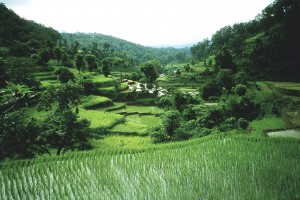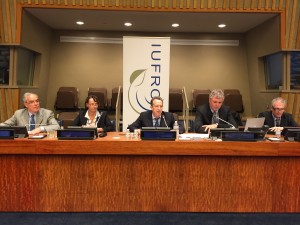Forests hold the potential to contribute to sustainable local development in many regions of the world. For this potential to be realized, rural dwellers need to have access to healthy forests, need to be linked to markets, and hold capacities to actively engage in forest product value chains. This requires an enabling legal environment and supportive policies. For the last two decades, considerable efforts and investment have been devoted to improve these enabling conditions in many locations and at different scales. Even so, in many places in the world where a forestry development potential may exist, deforestation and forest degradation, unfavourable legal environments and policies and competition with better endowed or politically well-connected entrepreneurs prevail.
The work of IUFRO’s Special Project World Forests, Society and Environment has recently focused on identifying what appear to be important conditions that foster or hinder meaningful progress towards improved forest-based livelihoods and the challenges for community and smallholder forestry as important strategies towards this end. Endeavours to improve forest-related livelihoods are situated in increasingly complex and dynamic contexts, with varying socioeconomic, institutional and biophysical characteristics and drivers that operate at different scales from the local to the global. A growing proportion of the world’s forests are degraded and areas of secondary forests are expanding, as are planted forests. These changes in forest cover take place in contexts characterized by an increasing diversity of actors, burgeoning demand for forest-based goods and services and growing pressures leading to the conversion of forest lands to other uses.
Despite the diverse contexts, some issues have been found to be important in harnessing the potential of forest landscapes to improve livelihoods. These issues include for example: well-defined secure rights to forests and trees; relatively stable regulatory framework that supports small holder and community initiatives; integration of primary producers into more lucrative value chains; access to formal credit; empowerment of local actors to take part in crucial decisions regarding forest management and use; and effective control of illegal activities and corruption.
The different conditions affecting local forest management, benefit capturing and related outcomes do not act in isolation, rather they interact in complex ways often undermining policies intended to support local forest use and management, or leading to unintended consequences.
The findings emphasize the need for more holistic and synergistic policies and measures and indicate the crucial importance of monitoring the primary livelihood improvements and resource sustainability outcomes of local efforts and external support efforts.
The IUFRO-WFSE side event at UNFF 11 concentrates on the above mentioned issues focusing on the conditions that foster meaningful progress towards improved forest-based livelihoods and the community and smallholder forestry as important strategies towards this end in changing contexts.
IUFRO-WFSE Side event at UNFF 11, New York, Monday 4 May 2015, 1:15-2:30 p.m., Conference room 4 (CR 4) – Flyer
Program:
Moderator: Glenn Galloway, University of Florida
Opening words: John Parrotta, IUFRO Vice-President
4 presentations:
1) Peter Holmgren, CIFOR: Changing forests under shifting institutional and economic contexts
2) Pia Katila, Natural Resources Institute, Finland: Enabling conditions for enhancing forest-based livelihoods
3) Glenn Galloway, University of Florida: Interaction among markets, policies and implementation
4) Wil de Jong, Kyoto University: The way forward – holistic approaches and synergistic policies are the key
Discussion



Leave a Reply